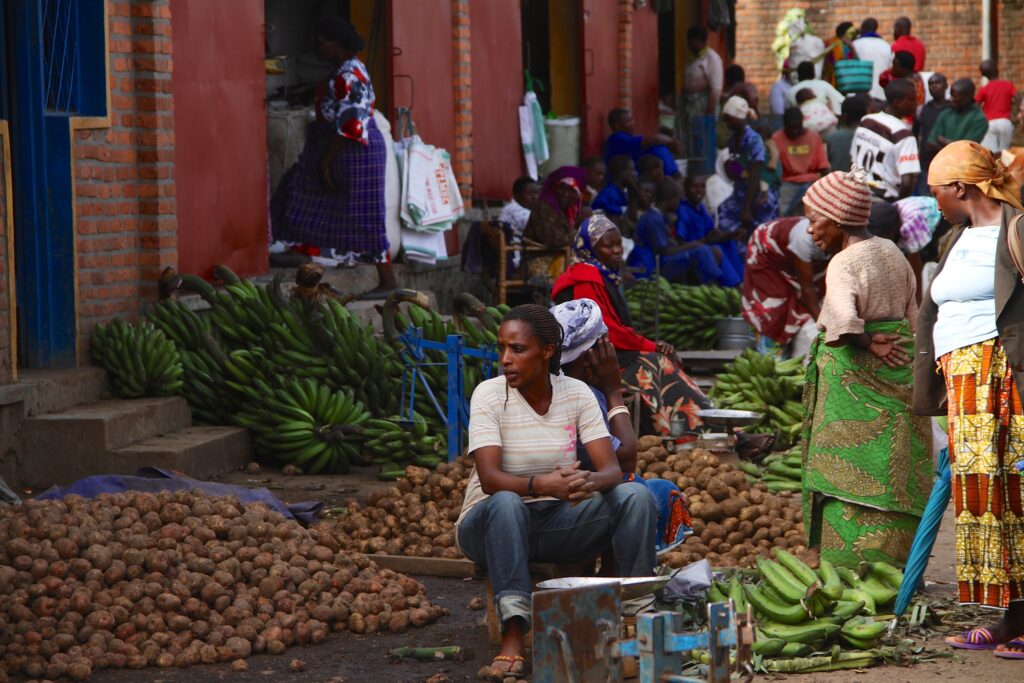How two villages in Rwanda have proven that peace and healing are possible
In Rwanda’s Northern Province, two villages – Buhumuro and Bumanzi – stand on opposite sides of the Mpenge River. For years following the 1994 genocide against the Tutsi, the two communities lived in a state of hostility and mistrust.
But now, through a series of dialogue sessions rooted in mutual empathy and shared understanding, International Alert’s project, USAID Dufatanye Urumuri, is supporting people in building a shared vision of lasting peace.

A challenge for healing
Until recently, Buhumuro and Bumanzi were divided by more than the river that runs between them. With a shared history of deep discord, the communities were neighbours but also adversaries marred by the prolonged effects of conflict.
Located close to Rwanda’s Volcanoes National Park, a lush green habitat at the side of the mountains, the two villages are part of Bukinanyana Cell (an administrative entity in Rwanda made up of villages). Locally, Buhumuro was perceived as home to members of the Hutu group, some of whom perpetrated the genocide against the Tutsi. While across the river, Bumanzi was an uninhabited patch of forest where Tutsi refugees chose to settle back in Rwanda after fleeing the Democratic Republic of Congo to escape persecution. This shift sparked serious ethnic tensions fuelled by past events and Bukinanyana became a place instantly divided.
Although both villages had since adopted new place names that, on the surface, appear positive, Buhumuro (place of good smell) and Bumanzi (place of moral excellence), the names still carried unspoken connotations of an undercurrent of ethnic division, shaping the way the communities viewed one another.
Where there were opportunities for economic collaboration and benefits, residents worked against each other, refusing to buy crops from one place to sustain livestock in the other and avoiding buying everyday goods such as milk, even at cheaper prices. Instead, they would spend extra time travelling to the nearest town, Musanze, to purchase the same items at greater cost.
Constant grievances meant that even essential water systems were sabotaged preventing safe water from flowing to the villages and resulting in a three-hour daily round trip to fetch water from a natural source. The hostility also extended to governance, where local leaders struggled to engage both villages in collective projects with mutual benefits.
Community work sessions (umuganda), a cornerstone of Rwandan unity, were boycotted, and joint meetings were impossible to organise.
A big hill to climb
When the team of the Urumuri project, which means ‘The Light’ in Kinyarwanda, asked the district of Musanze to identify the local area most in need of healing and reconciliation, the immediate answer was Bukinanyana Cell.
The challenge of bringing the villages together fell to community facilitator Ritah Mukandori, who volunteers with Alert’s project partner ARCT Ruhuka, and whose persistence eventually turned the tide. Initially, it was complicated to bring people together, and efforts were met with outright resistance. Ritah remembers:
[People] refused to sit in the same room. They told me, ‘We are enemies; we don’t belong together’.
Through patient support, Ritah began to introduce the idea of community dialogue. The earlier sessions were strained, with participants insisting they sit apart and not interact with one another. But as things progressed, residents began sharing their struggles and realising their common challenges. The healing sessions fostered acceptance and built trust, breaking down years of suspicion and hostility between these two villages in Rwanda and making it possible for people to sit and work together.
A remarkable journey
The effects of healing and reconciliation are deeply felt in Buhumuro and Bumanzi in Rwanda, touching every aspect of community life. Now, safe water serves both villages without fear of deliberate damage to the pumps, and the long daily journeys for water are over.
Markets have become thriving trade hubs, with goods and services exchanged freely, boosting the local economy. People host joint celebrations and casual gatherings, and there are shared savings groups and increased business opportunities.
Marie Rose Mukandayisenga, who married into Bumanzi, recalls:
I was warned not to step foot in Buhumuro. Now, I visit freely. We’re part of the same community.
Peace between the villages has not only created positive social and economic benefits: but areas of governance have also been transformed. Leaders who once struggled to encourage the villages to take part in development efforts have seen great strides with active involvement from people on both sides.
Edgard Rubuguza, Executive Secretary of Bukinanyana Cell, says:
The change is remarkable. Community work sessions are now attended by residents of both villages. This collaboration has made it easier to address broader issues like water supply and economic development.
There have also been positive gains from improved cooperation for governance structures. Joint initiatives, like the maintenance of shared infrastructure and the organisation of public forums, have strengthened local leadership’s capacity to deliver services.
The reconciliation process has demonstrated that effective governance is grounded in trust and collaboration, enabling leaders to serve their communities more effectively.
The power of reconciliation
The healing process between Buhumuro and Bumanzi in Rwanda shows us peace is possible in even the most challenging circumstances. The transformation has not only restored relationships, but it has also created a foundation for sustainable development. Residents support one another to overcome historical wounds, and leaders have gained the trust needed to drive collective progress.
Through the work of the USAID-funded Dufatanye Urumuri Project and with support from the government, the coming together of these two villages underlines how reconciliation can strengthen governance, foster economic resilience, and build lasting peace. The river that once divided the communities now flows as a symbol of unity, reminding us that even the deepest divides can be bridged.






